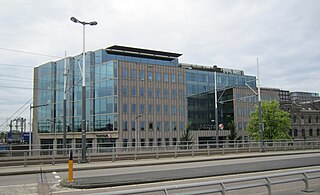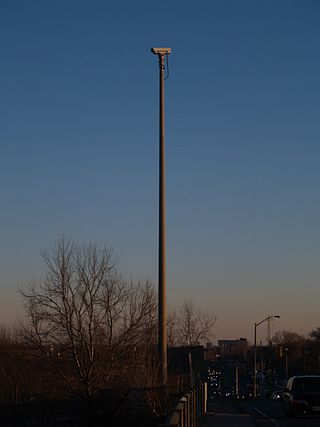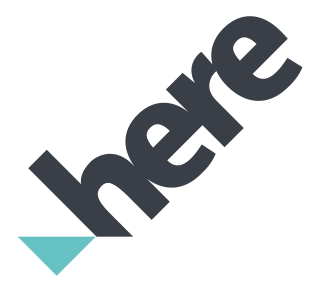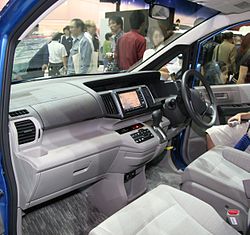
An intelligent transportation system (ITS) is an advanced application that aims to provide innovative services relating to different modes of transport and traffic management and enable users to be better informed and make safer, more coordinated, and 'smarter' use of transport networks.

The Acura TL is a car that was manufactured by Acura, the North American luxury division of Honda. It was introduced in 1995 to replace the Acura Vigor and was badged for the Japanese-market from 1996 to 2000 as the Honda Inspire and from 1996 to 2004 as the Honda Saber. The TL was Acura's best-selling model until it was outsold by the MDX in 2007. In 2005, it ranked as the second best-selling luxury sedan in the United States behind the BMW 3 Series, but sales decreased after the 2008 model year. Four generations of the Acura TL were produced, with the final fourth generation TL premiering in 2008 as a 2009 model and ending production in 2014, when it was replaced together with the TSX by the TLX.

The Honda Inspire is a mid-size sedan derived from the Honda Accord chassis. The first Inspire debuted in late 1989 as the Accord Inspire, a sister nameplate to the Honda Vigor. It was sold at different retail channels in Japan, known as Honda Verno for the Vigor/Saber, and as the Inspire at Honda Clio stores.

Traffic Message Channel (TMC) is a technology for delivering traffic and travel information to motor vehicle drivers. It is digitally coded using the ALERT C or TPEG protocol into Radio Data System (RDS) carried via conventional FM radio broadcasts. It can also be transmitted on Digital Audio Broadcasting or satellite radio. TMC allows silent delivery of dynamic information suitable for reproduction or display in the user's language without interrupting audio broadcast services. Both public and commercial services are operational in many countries. When data is integrated directly into a navigation system, traffic information can be used in the system's route calculation.

An automotive navigation system is part of the automobile controls or a third party add-on used to find direction in an automobile. It typically uses a satellite navigation device to get its position data which is then correlated to a position on a road. When directions are needed routing can be calculated. On the fly traffic information can be used to adjust the route.
Vehicle Information and Communication System (VICS) is a technology used in Japan for delivering traffic and travel information to road vehicle drivers. It provides simple maps showing information about traffic jams, travel time, and road work - usually relevant to your location and usually incorporating infrared beacons.

TomTom N.V. is a Dutch multinational developer and creator of location technology and consumer electronics. Founded in 1991 and headquartered in Amsterdam, TomTom released its first generation of satellite navigation devices to market in 2004. As of 2019 the company has over 4,500 employees worldwide and operations in 29 countries throughout Europe, Asia-Pacific, and the Americas.

Traffic reporting is the near real-time distribution of information about road conditions such as traffic congestion, detours, and traffic collisions. The reports help drivers anticipate and avoid traffic problems. Traffic reports, especially in cities, may also report on major delays to mass transit that does not necessarily involve roads. In addition to periodic broadcast reports, traffic information can be transmitted to GPS units, smartphones, and personal computers.
The Multi Media Interface (MMI) system is an in-car user interface media system developed by Audi, and was launched at the 2001 Frankfurt Motor Show on the Audi-Avantissimo concept car. Production MMI was introduced in the second generation Audi A8 D3 in late 2002 and implemented in majority of its latest series of automobiles.
Magellan Navigation, Inc. is an American producer of consumer and professional grade global positioning system receivers, named after Ferdinand Magellan, the first explorer to circumnavigate the globe. Headquartered in San Dimas, California, with European sales and engineering centres in Nantes, France and Moscow, Russia, Magellan also produces aftermarket automotive GPS units, including the Hertz Neverlost system found in Hertz rental cars. The Maestro, RoadMate, Triton, and eXplorist lines are Magellan's current consumer offerings. The company also produces proprietary road maps (DirectRoute), topographic maps (Topo), and marine charts (BlueNav) for use with its consumer GPS receivers.
Integration of traffic data with navigation systems enables navigation systems to use traffic and other related data to optimise routing and travel times by taking into account traffic conditions and other disruptions to traffic flows. The integration may occur in a number of ways. For example, integrated automobile navigation systems use an on-board navigation system and cellular telephone. The navigation system would use the global positioning system (GPS) to position the automobile with respect to streets in a map database, to determine a route to the destination and to update the location as the automobile moves. A cellular telephone in the automobile may then communicate with a traffic information server to obtain travel times for each street segment of the route, which would then be used to refine the planned route, or to offer to the driver as an alternative. The cellular telephone can also be used to provide dynamic travel time information to the traffic information server, with each automobile in the system periodically transferring travel times for each segment that is traversed. The traffic information server would then analyse travel times to update travel time data for each street segment, which is then available to other users when they next connect to the traffic server. Other integration models exist.

A Personal Navigation Assistant (PNA) also known as Personal Navigation Device or Portable Navigation Device (PND) is a portable electronic product which combines a positioning capability and navigation functions.

A satellite navigation device or satnav device, also known as a satellite navigation receiver or satnav receiver or simply a GPS device, is a user equipment that uses satellites of the Global Positioning System (GPS) or similar global navigation satellite systems (GNSS). A satnav device can determine the user's geographic coordinates and may display the geographical position on a map and offer routing directions.

A collision avoidance system (CAS), also known as a pre-crash system, forward collision warning system (FCW), or collision mitigation system, is an advanced driver-assistance system designed to prevent or reduce the severity of a collision. In its basic form, a forward collision warning system monitors a vehicle's speed, the speed of the vehicle in front of it, and the distance between the vehicles, so that it can provide a warning to the driver if the vehicles get too close, potentially helping to avoid a crash. Various technologies and sensors that are used include radar (all-weather) and sometimes laser (LIDAR) and cameras to detect an imminent crash. GPS sensors can detect fixed dangers such as approaching stop signs through a location database. Pedestrian detection can also be a feature of these types of systems.

Here Technologies is a Dutch multinational group specialized in mapping technologies, location data, and related automotive services to individuals and companies. It is majority-owned by a consortium of German automotive companies and American semiconductor company Intel whilst other companies also own minority stakes. Its roots date back to U.S.-based Navteq in 1985, which was acquired by Finland-based Nokia in 2007. Here is currently based in The Netherlands.

G-Book was a telematics subscription service provided by Toyota Motor Corporation in Japan for its Toyota- and Lexus-branded vehicles. G-Book allowed users to link with cellphones, personal digital assistants (PDA)'s, personal computers (PC) and G-Book equipped cars across Japan. It is based on the former GAZOO infrastructure of Toyota's membership-based information service and membership system, and it provides interactive information services via vehicle installed touch-screen wireless communication terminals. It also incorporates information from Toyota Mapmaster Inc. which updates digital mapping information and is used by various international companies.

Toyota Entune is an integrated multimedia navigation and telematics system for Toyota automobiles that provides satellite-based information on traffic, weather, sports scores, stocks, and fuel prices via subscription through SiriusXM. When connected to a compatible mobile phone running the Entune app via radio or USB cable, the system provides a browser and other apps, including music services such as iHeartRadio, Pandora and XM Satellite Radio. The cell phone app supported iOS, Android, and Blackberry with different versions utilizing cell data. The system could be controlled with (limited) speech recognition, and optionally include the “Safety Connect” personalization system.

CarWings, renamed NissanConnect in 2015, and also branded as Infiniti InTouch is a vehicle telematics service offered by the Nissan Motor Company to drivers in Japan, the United States, Canada, Great Britain, and most other countries. It provides mobile connectivity for on-demand traffic information services and internet provided maps displayed inside select Nissan vehicles. The service began in December 1997, and was introduced with the name Compass Link, having been installed in the 1997 Nissan Cedric, Nissan Gloria, Nissan President, Nissan Cima, Nissan Laurel, Nissan Leopard and the Nissan Elgrand. Compass Link was a service provided by Compass Link Co., Ltd. which was also offered to Mitsubishi and BMW vehicles in Japan beginning January 2000.

CarPlay is an Apple standard that enables a car radio or automotive head unit to be a display and controller for an iOS device. It is available on iPhone 5 and later models running iOS 7.1 or later.

Here WeGo is a web mapping and satellite navigation software, operated by HERE Technologies and available on the Web and mobile platforms. It is based on HERE's location data platform, providing its in-house data, which includes satellite views, traffic data, and other location services. Maps are updated every two or three months.

















